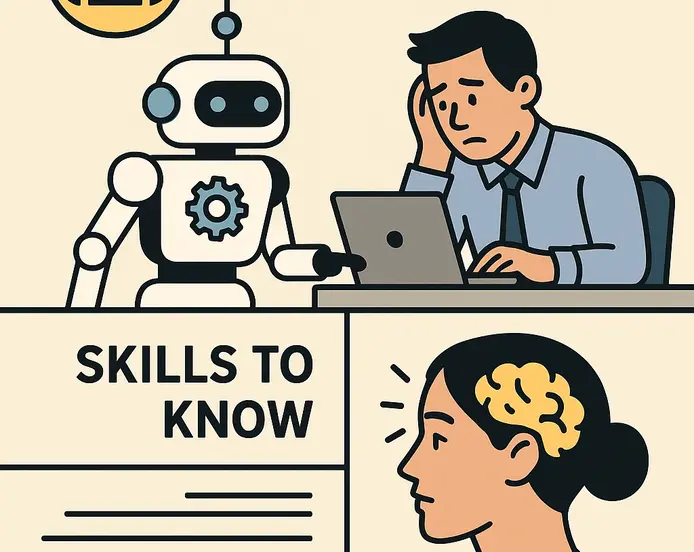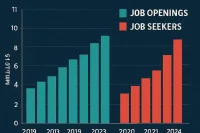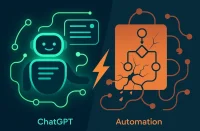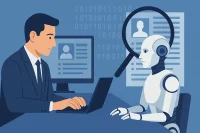AI in the workplace has reached a critical inflection point, with 78% of organizations using artificial intelligence last year according to a recent Stanford University report, up from 55% the year before. This rapid adoption is fundamentally reshaping how we work, what skills are valuable, and which careers will thrive in an AI-driven economy. The transformation is happening faster than ever, with professionals entering the workforce today expected to have about twice as many jobs as those who entered just 15 years ago.
The impact of AI extends far beyond simple automation, changing how we write reports, communicate with colleagues, gather information, and approach problem-solving. While this creates anxiety for many workers – with 41% globally expressing nervousness about the need to learn AI – it also presents unprecedented opportunities for those willing to adapt and develop the right skills.
The key to success in this new landscape is understanding which jobs are most affected, which human skills remain valuable, and how to gradually acclimate to AI tools without being overwhelmed by the rapid pace of change.
The Scale of Change: AI’s Rapid Workplace Integration
This represents one of the most significant workplace transformations in history, with change happening at an unprecedented pace. One in five professionals today work in jobs that didn’t exist in the year 2000, including roles like data scientist and customer success manager that have emerged from technological advancement.
The acceleration of change means that workers must continuously adapt their skills and approaches to remain relevant. The traditional model of learning a skill set and applying it throughout one’s career is no longer viable in an AI-driven economy where job requirements can shift dramatically within short timeframes.
This rapid transformation affects virtually every industry and job function, from marketing and engineering to arts and design, requiring workers to develop new competencies while maintaining their core expertise. The challenge is not just learning to use AI tools, but understanding how to integrate them effectively into existing workflows and processes.
Jobs Most Affected: Where AI is Making the Biggest Impact
The most significant impact is on jobs that involve data processing, content creation, and routine analytical tasks. Marketing, engineering, and arts and design are already experiencing massive changes in the skills required to perform these roles effectively.
The transformation is not limited to technical fields, as AI is changing how professionals write reports, communicate with colleagues, and gather information across all industries. Even traditional office roles are being reshaped as AI tools become more sophisticated and widely adopted.
However, the impact varies significantly by job type. Roles that require human-to-human interaction, physical presence, or complex interpersonal skills are being affected more slowly. Real estate agents, healthcare workers, and community service professionals are among those seeing less immediate disruption from AI implementation.
Adapting to AI’s Impact on Work
From marketing to engineering, AI is transforming how work gets done — reshaping skills, roles, and career paths. Employers can stay ahead by hiring adaptable professionals ready to leverage AI tools while bringing human creativity and judgment to the table. Post your job on WhatJobs today and connect with top candidates prepared for the AI-driven future of work.
Post a Job Free for 30 Days →Jobs Less Affected: Where Human Skills Remain Essential
Less impact is seen on jobs that require physical presence, human-to-human interaction, or complex emotional intelligence. Real estate agents, healthcare workers, and community service professionals are among those whose roles remain relatively stable in the face of AI advancement.
Physical jobs like oil field workers and roles requiring hands-on interaction are also less susceptible to AI disruption, as these positions depend on human dexterity, judgment, and physical presence that AI cannot replicate.
Physician’s assistants and other healthcare roles that require complex human interaction and medical judgment are among the least affected by AI, though even these roles are beginning to incorporate AI tools for data analysis and diagnostic support.
The Skills Revolution: What Employers Really Want
This trend is driving a fundamental shift in the skills that employers value most highly. While technical AI skills are important, the most in-demand competencies are actually human skills that complement rather than compete with AI capabilities.
Communication skills, including conflict mitigation and the ability to work collaboratively, are increasingly valuable as teams navigate AI implementation and integration. Adaptability and the ability to quickly adjust to workplace changes are essential for success in an AI-driven environment.
Innovation and creative thinking remain highly valued, as these are areas where human judgment and creativity provide significant advantages over AI systems. Public speaking and presentation skills are also growing in importance as organizations need people who can explain AI concepts and guide teams through technological changes.
The 85% Rule: Universal Skill Transformation
Virtually every professional is affected, with 85% of workers expected to see at least a quarter of their required skills change due to AI implementation. This means that even workers in traditionally stable fields must prepare for significant skill evolution.
The transformation is not just about learning to use AI tools, but about fundamentally changing how work is performed. Professionals must develop new approaches to problem-solving, communication, and collaboration that leverage both human and AI capabilities.
This universal impact means that continuous learning and skill development are no longer optional but essential for career survival. Workers must embrace lifelong learning and remain adaptable to stay relevant in an AI-driven economy.
Getting Started: Baby Steps for AI Adoption
Getting started can seem intimidating, but it doesn’t require technical expertise or formal training. Most AI tools are available for free or at low cost, making it easy for workers to begin experimenting and learning at their own pace.
The key is simply to start using AI tools for everyday tasks, whether that’s asking ChatGPT to help with a business plan, using Copilot for coding assistance, or experimenting with Gemini for creative projects. The learning process is more like working with a helpful colleague than mastering a complex technical skill.
There are countless free courses and resources available online, and workers don’t need to become AI experts overnight. The goal is to develop familiarity and comfort with AI tools while gradually expanding their capabilities and applications.
The Human-AI Collaboration Model: Working Together, Not Against Each Other
This approach is most effective when humans and AI systems work together rather than in competition. The most successful organizations are those that develop models of human-AI collaboration that leverage the strengths of both.
This collaboration requires workers to develop skills in AI oversight, prompt engineering, and result interpretation. Rather than replacing human judgment, AI tools can enhance human capabilities when used thoughtfully and strategically.
The goal is not to become dependent on AI, but to develop the ability to work effectively with AI systems while maintaining critical thinking and decision-making skills. This balance is essential for long-term career success in an AI-driven economy.
The Anxiety Factor: Managing Fear and Embracing Opportunity
This trend creates understandable anxiety for many workers, with 41% globally expressing nervousness about the need to learn AI skills. However, this anxiety can be managed through gradual exposure and skill development.
The key is to approach AI adoption as an opportunity rather than a threat. Workers who embrace AI tools and develop complementary skills often find that they become more valuable to employers, not less. The goal is to become someone who can work effectively with AI rather than someone who is replaced by it.
Support and training from employers, colleagues, and professional networks can help reduce anxiety and accelerate learning. The most successful workers are those who seek out opportunities to learn and experiment with AI tools in a supportive environment.
Future-Proofing Your Career: Long-Term Strategies
Workers must develop long-term strategies for career sustainability and growth in this evolving landscape. This means focusing on skills that complement AI capabilities while remaining adaptable to technological change.
The most future-proof careers are those that combine technical knowledge with strong human skills like communication, creativity, and emotional intelligence. Workers should focus on developing expertise in areas where human judgment and interpersonal skills provide significant value.
Continuous learning and skill development are essential, but so is maintaining a growth mindset and willingness to adapt. The workers who thrive in an AI-driven economy are those who see change as an opportunity rather than a threat.
The Path Forward: Embracing Change While Maintaining Humanity
This represents both a challenge and an opportunity for workers willing to adapt and grow. The key is to embrace AI tools while maintaining the human skills that make us unique and valuable.
This means developing technical proficiency with AI tools while strengthening communication, creativity, and interpersonal skills. The most successful workers will be those who can effectively bridge the gap between human and artificial intelligence.
The future belongs to those who can work collaboratively with AI systems while maintaining the human touch that makes work meaningful and effective. This balance is the key to long-term career success in an AI-driven economy.
Frequently Asked Questions
What does AI in the workplace mean for job security?
AI in the workplace means that job security depends on adaptability and skill development rather than static expertise, with 85% of professionals needing to update at least a quarter of their skills due to AI implementation.
How does AI in the workplace affect different types of jobs?
AI in the workplace affects jobs differently based on their requirements, with data-heavy and routine tasks being most impacted while human-to-human interaction and physical jobs remain relatively stable.
What are the most important skills for AI in the workplace?
The most important skills include communication, adaptability, innovation, public speaking, and the ability to work collaboratively with AI systems while maintaining critical thinking and human judgment.
How can workers get started with AI in the workplace?
Workers can get started by experimenting with free AI tools like ChatGPT, taking online courses, and gradually incorporating AI into everyday tasks while focusing on developing complementary human skills.
A Real-World Example: Maria’s AI Journey
Maria Rodriguez, a 32-year-old marketing manager from Chicago, exemplifies how AI in the workplace can transform careers when approached strategically. Initially intimidated by AI tools, Maria decided to start small by using ChatGPT to help with email writing and content creation.
“I was nervous about AI in the workplace at first, but I realized I needed to adapt or risk being left behind,” Maria explains. “I started by using AI to help with routine tasks like drafting emails and creating social media content, which freed up time for more strategic work.”
Maria’s gradual approach to AI adoption allowed her to build confidence while developing new skills. She learned to use AI tools for data analysis, content creation, and market research, while focusing on developing her communication and strategic thinking abilities.
“AI in the workplace taught me that the key is finding the right balance between human creativity and AI efficiency,” Maria says. “I now use AI to handle routine tasks while focusing on relationship building, strategy, and creative problem-solving that requires human judgment.”
Within a year, Maria was promoted to senior marketing manager and became the go-to person in her company for AI implementation. Her experience demonstrates that workers who embrace AI while developing complementary human skills can actually become more valuable to employers rather than being replaced by technology.




